Understanding the Height of Burj Khalifa: An Exploration
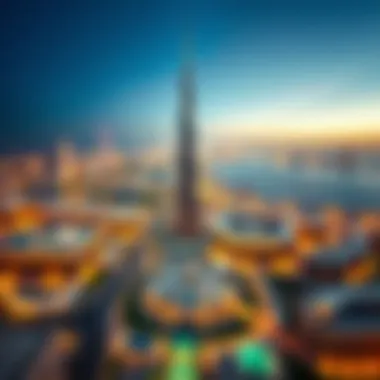

Intro
The Burj Khalifa, an iconic marvel, stands as a towering testament to human ingenuity and ambition. With a height of 828 meters, it is the tallest structure on the planet and dominates the skyline of Dubai. But the significance of this colossal building stretches far beyond its impressive measurements. It plays a pivotal role in not just shaping the architectural landscape, but also in influencing real estate trends, tourism, and global perceptions of modern construction.
In this article, we'll delve into the intricacies of Burj Khalifa's height. We will explore how its remarkable design embodies advancements in engineering and construction, as well as its impact on Dubai's economy and culture. Additionally, we will draw comparisons with other skyscrapers, scrutinizing what makes the Burj Khalifa a focal point in discussions about mega-structures. Prepare to uncover the layers behind this architectural gem as we embark on a thorough examination.
Preamble to Burj Khalifa
Burj Khalifa stands as not just a towering structure, but a beacon of architectural ingenuity and urban ambition. When people speak of skyscrapers, Burj Khalifa often tops the list—quite literally. This introduction sets the stage for our exploration, delving deeply into the importance of this colossal building, its structural marvel, and the historical waves it has made in the skyline of Dubai, and indeed, the world.
Overview of the Structure
The Burj Khalifa, soaring at an impressive height of 828 meters, holds the record as the tallest building in the world since its completion in 2010. Designed by the renowned architectural firm Skidmore, Owings & Merrill, the structure is characterized by its sleek, tapering silhouette, which draws inspiration from the desert flower Hymenocallis. This echo of nature in a man-made construct is not just an aesthetic preference; it plays a crucial role in its functionality, maximizing views while reducing wind resistance.
Such architectural brilliance isn't only about height; it's about elegance and endurance. Built with an advanced concrete mix and columns that taper as they ascend, Burj Khalifa embodies the essence of what can be achieved when human creativity meets cutting-edge engineering. It has become a symbol of Dubai's sky-high aspiration, signifying a shift in the architectural landscape and our collective belief in the possibilities of modern construction.
Historical Significance
Burj Khalifa isn't merely a triumph of engineering; it's a cultural touchstone for Dubai and a marker of its growth in the 21st century. Built during a time when many were wary of the economic climate, this skyscraper symbolized hope, ambition, and the country’s commitment to forging a new path in the global economy. Its completion in 2010 came at a moment when the world was still recovering from the financial turmoil, rendering its rise even more impactful.
The building serves as a testament to what can be achieved with vision and tenacity—both in construction and in urban planning. By becoming a focal point within Downtown Dubai, Burj Khalifa has drawn countless tourists, investors, and potential residents, acting as a catalyst for economic growth and urban development. Many view the tower as a symbol of resilience, embodying how communities can emerge stronger from adversity, making it not just a building, but a part of the story of Dubai's revival and ambition on the world stage.
"Burj Khalifa represents the heights of human capability and is a living narrative of progress and innovation."
As we dive deeper into what makes Burj Khalifa such a notable structure, understanding its height isn't just about numbers; it's about the methods, technologies, and cultural impacts woven intricately into its very fabric.
The Height of Burj Khalifa
Discussing the height of Burj Khalifa isn’t just about numbers; it’s about its monumental place in the world of architecture and engineering. Standing at an official height of 828 meters, Burj Khalifa not only holds the record for the tallest building globally but also serves as a beacon of Dubai’s ambitious vision. This section explores the intricacies of its height, shedding light on why it matters to investors, real estate analysts, and urban developers alike.
Official Height Measurement
The official height of Burj Khalifa, precisely clocked at 828 meters (2,717 feet), is more than a mere assertion of scale. This measurement includes its tip, which is one of its most iconic features—the spire extending skyward, adding to its grandeur. When the building was completed in 2010, it dazzled the world, challenging our perception of what a skyscraper could be.
It’s essential to note that this official height measurement was sanctioned by the Council on Tall Buildings and Urban Habitat, the body that oversees the criteria for tall buildings globally. Unlike other structures that might count only usable floors, the Burj Khalifa’s measurement includes the spire—a decision that directly influences its standing in the thematic rankings of skyscrapers. Additionally, the building's height reflects modern engineering techniques, combining innovative design with advanced materials and construction methods.
"Burj Khalifa’s height is not just a question of engineering, but rather a narrative of ambition and vision that has reinvigorated urban landscapes."
Height in Context
To fully appreciate the significance of Burj Khalifa's height, it’s important to place it within a broader context of architectural evolution. The skyscraper eclipses many of the world's other heights, including the 632-meter Shanghai Tower and the 601-meter Abraj Al Bait Clock Tower. But it’s not just about the tower itself; it’s about the trend it represents in urban architecture.
In Dubai, the Burj Khalifa isn't merely a building; it's a symbol of economic prosperity and technological prowess. Its height serves as an attraction, drawing millions of tourists each year, eager to experience its observation deck on the 148th floor. Furthermore, the structure's height elevates it beyond just a point on the skyline: it frames the very identity of the city, a beacon for potential investors and a catalyst for real estate activity across Dubai.
Examining comparable skyscrapers, one might also reflect on the architectural ambitions of cities worldwide. As cities expand, the race for height serves in many respects as a marker of economic and cultural significance. The context of Burj Khalifa's height reminds us that it's not only about surpassing peers but also about crafting an urban narrative that speaks to growth, potential, and vision—both for Dubai and for the concept of skyscrapers at large.
In closing, the height of Burj Khalifa is not merely a statistic; it’s a testament to the possibilities that lie within urban landscapes, transforming the skyline and inviting new conversations around future developments, architectural refresh, and the ever-evolving definition of altitude in modern society.
Engineering Marvels
The Burj Khalifa stands as more than just a towering structure; it's a testament to human ingenuity and ambition. This section dives into the engineering marvels that make this skyscraper not only the tallest building in the world but also an architectural triumph. By examining construction techniques, materials used, and strategies for wind resistance, we uncover the intricate details that contribute to its stability, aesthetics, and overall effectiveness in the bustling environment of Dubai.
Construction Techniques
The construction of the Burj Khalifa required innovative approaches that pushed the boundaries of traditional building methods. One of the significant elements is the reinforced concrete core, which serves as the backbone of the structure. This core is surrounded by a series of concrete and steel frameworks designed to withstand the massive weight and stress of the building.
The builders used a method known as the jump-form technique, which allowed them to build the walls in sections. This technique ensured that the building could rise quickly while maintaining consistency and safety. As each section is completed, the next layer is added, rather like stacking blocks, allowing for continuous work without undermining the overall structure.
Additionally, a high-strength concrete mix was engineered specifically for this project to support the immense vertical load. The construction involved more than just putting bricks on top of each other; it was akin to solving a complex puzzle while working with limited space and a time crunch.
Materials Used
When it comes to skyscrapers, the choice of materials is pivotal, considering both longevity and aesthetic appeal. For Burj Khalifa, several unique materials were selected to ensure durability and visual impact.

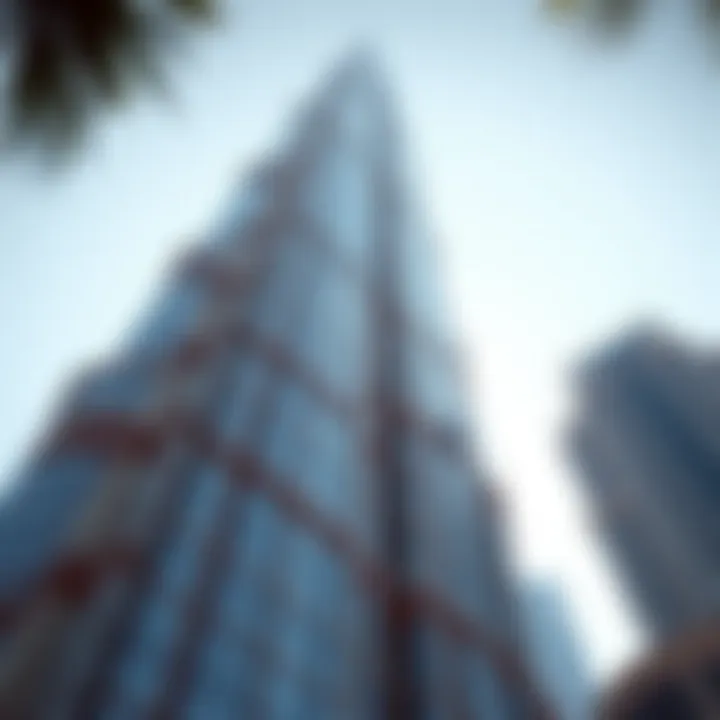
- Reinforced Concrete: Utilized for the core and floors, it provides a strong yet flexible structure capable of withstanding earthquakes and wind pressures.
- Glass and Steel: The exterior is adorned with over 103,000 square meters of glass, reflecting the sun's rays beautifully while providing breathtaking views from within. The steel used in the structural framework ensures a robust build that can handle both weight and pressure.
- Aluminum: Used extensively in the cladding, aluminum not only adds a sleek finish but also keeps the weight down, allowing for a lighter structure overall.
Choosing these materials was not an arbitrary decision; they were selected for their thermal efficiency and sustainability. The use of reflective glass minimizes heat absorption, reducing energy costs significantly.
Wind Resistance Strategies
In a city where the winds can be fierce, standing tall requires a clever strategy to combat these forces. Burj Khalifa employs several strategies to ensure that it remains stable in high winds.
One primary method is its tapered design, which reduces wind loads and allows air to flow around the building rather than straight into it. The tower’s spiraling shape acts somewhat like an airplane wing, streamlining airflow and minimizing turbulence.
Moreover, the building features a triadic structural system, which splits the total height into three segments that provide natural wind resilience. This design allows specific sections to flex and absorb wind pressure, minimizing the risk of structural damage.
Architectural Design Elements
The architectural design elements of the Burj Khalifa are not merely aesthetic choices; they play a crucial role in defining the skyscraper's identity and functionality. Every inch of its design embodies meticulous planning and forward-thinking approaches. With a focus that balances form, structure, and environment, these elements contribute significantly to how the Burj Khalifa stands as a monument in Dubai's skyline.
Inspiration Behind the Design
Burj Khalifa's design is inspired by the natural world, reflecting the local culture and environment. The building's shape resembles a desert flower, which is both a nod to Dubai's heritage and a symbol of growth amid a harsh landscape. The sketch by architect Adrian Smith resembles a spider lily—an elegant flower capable of thriving in arid conditions, representing life and beauty against a backdrop of sand.
This design choice also serves functional purposes. The flower-like shape allows for maximum structural stability while providing stunning views from each level. The overall tapering silhouette increases wind resistance, ensuring that the building can withstand its own great height.
Moreover, each component of the design is not just conceptual; it translates into something practical. For instance, the three distinct wings of the structure form a Y-shape, enhancing the floor area while minimizing wind load. This thoughtful consideration highlights an underlying principle in modern architecture: aesthetic appeal must also deliver practical results—something Burj Khalifa succeeds in magnificently.
Key Architectural Features
Several key architectural features make the Burj Khalifa an outstanding example of modern engineering:
- Tapering Structure: The building narrows as it rises, reducing wind pressure and ensuring stability, which is vital for such tall structures.
- Mixed-Use Spaces: The Burj Khalifa houses residential, commercial, and leisure spaces, blending living and working environments harmoniously.
- Sky Lobbies: Designed for both functionality and social interaction, these lobbies provide access to various facilities while offering spectacular views of the landscape.
- Sustainable Elements: The building incorporates elements that lessen its environmental footprint, such as water recycling systems and energy-efficient glass that helps to regulate temperature inside.
- Observation Decks: Located on the 148th floor, the observation decks provide breathtaking panoramic views of Dubai, drawing visitors globally.
In closing, the architectural elements of the Burj Khalifa showcase how creativity intertwined with functionality can lead to remarkable structures. It stands as a testament not just to Dubai's aspirations but also to what is possible in modern architecture and urban development.
"An architectural wonder, Burj Khalifa challenges previous constructs of what is possible—pushing the boundaries of height, imagination, and design."
Through the extensive use of local inspiration while embracing cutting-edge technology, these design features not only reflect the identity of Dubai but also set a benchmark for future architectural endeavors. Each element offers insights that continue to fuel interest from investors, architects, and enthusiasts alike. As such, the study of these architectural design features is essential for understanding the broader significance of the Burj Khalifa in both a cultural and economic context.
Comparative Analysis with Other Skyscrapers
In examining the majestic Burj Khalifa, one cannot overlook the significance of comparing it to other skyscrapers around the world. Comparative analysis sheds light on various architectural, engineering, and cultural aspects that define tall buildings. It brings perspective to Burj Khalifa's stature and standing in the ever-evolving skyline of skyscraper engineering. This analysis allows investors, agents, and analysts to appreciate innovations and draw simpile lessons in urban development.
Not only does it highlight what makes Burj Khalifa unique, but it also demonstrates the benchmarks for height, aesthetic, and structural integrity within global architecture.
Global Tall Building Rankings
As of 2023, Burj Khalifa stands tall at 828 meters, making it the tallest building in the world. However, it’s crucial to note that its successors, like the Shanghai Tower and the Abraj Al Bait Clock Tower, are not far behind.
- Ranking:
- Burj Khalifa: 1st place
- Shanghai Tower: 2nd place at 632 meters
- Abraj Al Bait Clock Tower: 3rd place at 601 meters
The concept of ranking in skyscrapers serves to educate potential investors on property values and investment opportunities. Understanding where different structures stand globally infuses a sense of competition and motivates advancements in design and engineering.
Burj Khalifa vs. Shanghai Tower
The Shanghai Tower, while lower in height than the Burj Khalifa, introduces a different narrative in the world of skyscrapers. Both buildings are feats of engineering, but they cater to distinct urban needs and design philosophies.
- Height:
Burj Khalifa's 828 meters extends its mark as a monumental structure, aiming for the skies. In contrast, the Shanghai Tower reaches 632 meters, intertwined with the fabric of Shanghai's fast-paced urban life. - Design Philosophy:
- Burj Khalifa: Designed by Adrian Smith of Skidmore, Owings & Merrill, it reflects Islamic architecture with its flower-like shape, emphasizing the region's cultural roots.
- Shanghai Tower: Designed by Gensler, this building showcases modernity with its twisting form and sustainable features, highlighting energy efficiency and environmental consciousness.
The differences offered by the Shanghai Tower invite potential investors to reconsider what height and architecture mean. While height captures the eye, innovative designs grow interest in city planning and sustainability.
Burj Khalifa vs. Abraj Al Bait Clock Tower
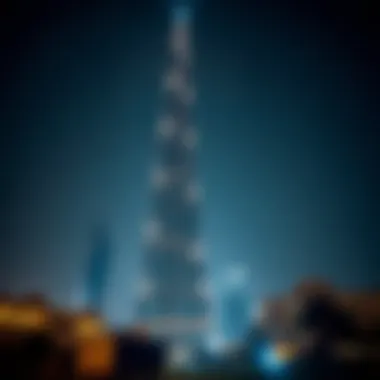
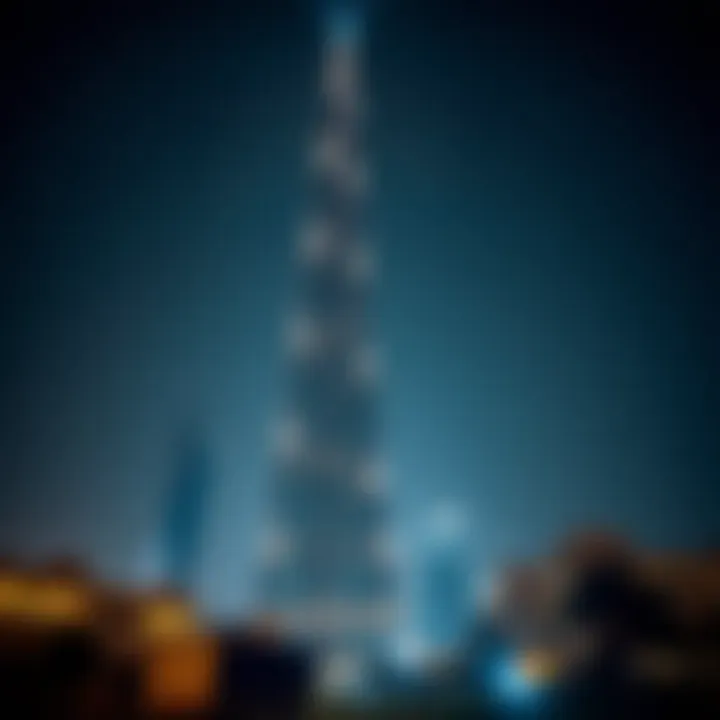
In a comparison with the Abraj Al Bait Clock Tower, located in Mecca, different factors come into play. Despite being shorter at 601 meters, Abraj Al Bait serves an entirely different purpose.
- Cultural Significance:
The Abraj Al Bait Tower serves as a significant landmark for Islamic pilgrimage, providing essential services near the world's largest mosque. - Height vs. Purpose:
- Burj Khalifa symbolizes luxury and opulence, attracting tourists and residents with its lavish design and amenities.
- Abraj Al Bait, on the other hand, emphasizes practicality and community, engineered for a high influx of visitors during Hajj.
Both buildings offer valuable insights into how regional needs shape architectural designs. Understanding these factors is essential for stakeholders involved in real estate and urban planning, as cultural relevance can greatly impact marketability and investment potential.
"Comparative analysis illuminates how Burj Khalifa's majestic height shapes not just the skyline but also the dynamics of cultural and architectural trends globally."
Comparing Burj Khalifa to its counterparts helps to enrich the overall understanding of not just what makes it remarkable, but also the evolution of skyscrapers as a pillar of modern urban environments.
Impact on the Dubai Skyline
The Burj Khalifa doesn’t just touch the clouds; it redefines them. Rising to a staggering height of 828 meters, it is not only a feather in the cap of Dubai but also a beacon for the entire region. This singular tower has a multifaceted impact on the Dubai skyline, functioning as a cultural symbol and a driving force for urban development.
Burj Khalifa as a City Landmark
When you think of Dubai, the Burj Khalifa instantly springs to mind. It’s more than just an impressive architectural feat; it’s emblematic of UAE's rapid growth and aspirations on the global stage. Locally, many people view it as a proud landmark, showcasing what can be achieved through innovation and ambition.
From the ground, its sleek silhouette is a marvel, cutting a striking figure against the desert sky. At night, the tower lights up, creating a dazzling display visible from miles away. The light shows and firework displays that often accompany special occasions further amplify its significance.
"The Burj Khalifa is a living symbol, reflecting the ambition of a city that constantly strives to redefine its limits."
Its role as a tourist hot-spot can't be understated either. Visitors flock from all corners of the world, drawn by the promise of breathtaking views and the opportunity to experience an iconic slice of Dubai. The observation deck on the 148th floor offers panoramic views that are nothing short of breathtaking, further enhancing its stature as a landmark.
Influence on Urban Development
The Burj Khalifa has set the tempo for urban development around it. The city has morphed into a bustling metropolis, with the areas surrounding the tower focusing on luxury, hospitality, and commerce. Developers have seized the opportunity to erect residential complexes, luxury hotels, and retail spaces in its vicinity, establishing the downtown area as a hub for social and economic activity.
Some of the noteworthy projects that have emerged around the Burj Khalifa include:
- The Dubai Mall: One of the largest shopping malls in the world, extending the attraction of the tower.
- The Dubai Fountain: Offering a stunning water display against the backdrop of the Burj Khalifa.
- Residential Developments: High-end apartments that provide residents with front-row seats to the magical views.
This, in turn, has fueled the real estate market, adding to the demand for properties in the vicinity. Investors seek to capitalize on the prestige associated with living near such an iconic landmark, turning the surrounding areas into hot commodities.
Moreover, the Burj Khalifa has made Dubai a focal point for international events and conferences, attracting businesses to set up shop nearby and driving investment in the community. It has fostered an environment rich in economic opportunities, positioning Dubai as a truly global city.
Cultural and Economic Influence
The Burj Khalifa stands not just as a towering achievement in engineering but as a cultural icon that encapsulates the spirit of modern Dubai. Its height and design have significant implications, influencing various sectors within the city and beyond. This section delves into two critical aspects: the role of the Burj Khalifa as a magnet for tourists and its impact on the real estate market in the area.
Tourism Attraction
Tourism plays an indispensable role in Dubai’s economy, and the Burj Khalifa serves as a primary attraction that draws millions of visitors each year. Standing at a staggering 828 meters, it holds the title of the tallest building in the world, an achievement that naturally piques interest worldwide. The observation decks on the 124th and 148th floors provide breathtaking views that are hard to match elsewhere, prompting many travelers to make a trip specifically to experience that unique perspective.
Beyond just the height, the Burj Khalifa offers immersive experiences, such as the light and fountain shows that occur daily at its base. Visitors flock not only for the architectural marvel itself but also for the vibrant atmosphere that surrounds it. Local cafes and shops thrive on the traffic generated by the constant influx of tourists, fostering a lively community vibe.
In 2019 alone, an estimated 1.87 million people visited the observation decks of the Burj Khalifa, showcasing its vital role in tourism for the region.
Contribution to Real Estate Market
The influence of the Burj Khalifa extends into the real estate sector, driving demand and property values around the surrounding areas. As a symbol of luxury and modernity, its presence elevates the desirability of nearby residential and commercial developments. Property developers around the Burj Khalifa have seized the opportunity to create high-end living spaces and office complexes, resulting in a marked increase in real estate activity in Downtown Dubai.
The reputation of Burj Khalifa as a prime address often leads prospective buyers and tenants to seek properties in its vicinity. As a result, real estate prices have surged, with many properties offering premium prices for the view or proximity to the tower. Investors consider the area an attractive option, driven by the potential for high return on investment.
Additionally, the architectural grandeur of the Burj Khalifa itself has been emulated in various projects across Dubai, further solidifying the community as a hub for luxury living. New developments are often designed with the intent of creating synergy with the iconic structure, enhancing the overall aesthetic and value of the neighborhood.
In essence, the Burj Khalifa does not merely stand as a skyscraper; it operates as a powerful catalyst for tourism and real estate growth, weaving its influence into the very fabric of Dubai's cultural and economic landscape.
Future Developments Around Burj Khalifa
The Burj Khalifa stands not just as an architectural marvel, but as a centerpiece in the ever-evolving landscape of Dubai. As urban development continues to advance, the area surrounding this iconic skyscraper is set to undergo further transformations. Understanding these future developments provides insights into how stakeholders, including investors, real estate agents, and urban planners, view this part of the world as ripe with potential. The developments around Burj Khalifa are not mere constructions; they promise to shape the social and economic fabric of Dubai as it leaps into the future.

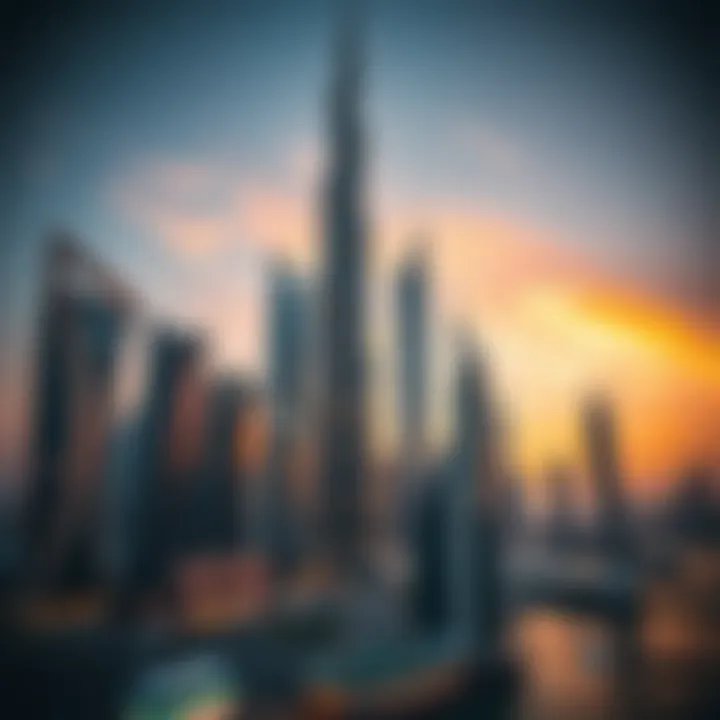
Upcoming Projects
Dubai has pledged to maintain its position as a leader in innovative urban design. Several ambitious projects are on the horizon:
- The Dubai Creek Tower: Positioned as a new contender for the title of the world's tallest tower, this project aims to enhance the skyline further and enhance tourism in the area.
- Dubai Opera District: This cultural hub is designed to host performances and art exhibitions, fostering creativity and drawing in visitors from around the globe.
- Mixed-use Developments: Various projects like the Dubai Mall expansion and residential towers are planned, which will cater to a diverse range of lifestyles, appealing to families and young professionals alike.
These initiatives are not merely about creating more structures. They emphasize the need for mixed-use spaces that support community engagement, commerce, and leisure. As these projects materialize, they will heavily influence how current and potential investors perceive market trends in Dubai's real estate sector.
Sustainability Initiatives
Amid these developments, sustainability remains at the forefront of urban planning discussions. Fueled by a growing awareness of climate change and the environmental footprint of mega-structures, Dubai is investing in innovative green technologies. These initiatives surrounding Burj Khalifa include:
- Green Spaces: More parks and green areas are being integrated into urban planning, focusing on improving air quality and enhancing residents' quality of life.
- Smart Building Technologies: Upcoming projects aim to incorporate intelligent building systems designed to reduce energy consumption and improve efficiency.
- Water Conservation Strategies: New developments around the Burj Khalifa will feature state-of-the-art water recycling systems, ensuring sustainability in a city that often wrestles with water scarcity.
The combination of large-scale projects and sustainability initiatives is setting the stage for Burj Khalifa to remain not only a marvel of architecture but also a leading example of modern urban living.
Addressing urban growth while remaining mindful of the environment is crucial. The direction of future developments shapes not only the visual landscape but also impacts the real estate market dynamics and overall economic opportunities in the vicinity of Burj Khalifa.
Visiting Burj Khalifa
Visiting Burj Khalifa is nothing short of a lofty experience for anyone venturing into Dubai. Standing at a staggering height, it's not just a testament to architectural excellence; it's a symbol of the city’s ambition and growth. When you're in the vicinity of this colossal structure, it's hard not to feel a wave of awe wash over you. This section will shed light on the myriad elements that make a visit to Burj Khalifa a must, focusing on two main aspects: the observation deck experience and the dining and entertainment options available.
Observation Deck Experience
The observation decks of Burj Khalifa are among the highest in the world, offering a vantage point that seems to stretch across the entire skyline. The journey begins in the elevator, which reaches speeds that can take your breath away. As you ascend, the anticipation builds, blending the thrill of the rapid ascent with the knowledge that you are climbing to the top of the tallest building in the world.
Once you arrive at the deck, prepare to lose yourself in a panoramic view that seems to fade into infinity. From here, the sprawling desert meets the vibrant city, and the Gulf glistens under the sun. It’s a scene that captivates and stirs emotions, often leaving visitors momentarily speechless.
- Key Highlights of the Experience:
- Interactive Displays: Guests can delve deeper into the history and engineering marvels behind Burj Khalifa through interactive screens.
- Observation Points: Designated areas for photography offer unparalleled views, making captures easy and Instagram-ready.
- Guided Tours: Engaging guides share insights that enrich the experience, providing context to what you’re seeing.
With its distinct viewing platform, visitors often find themselves immersed for hours, responding to the allure of seeing the world from such an unparalleled elevation.
Dining and Entertainment Options
After soaking in the views, the experience continues with a range of dining options within Burj Khalifa that cater to various tastes. Dining here isn’t just about the food; it’s an extension of the entire observation experience, with many restaurants offering menus inspired by global cuisines, all while overlooking the vibrant skyline of Dubai.
- Noteworthy Dining Experiences Include:
- At.mosphere: Located on the 122nd floor, this high-end restaurant specializes in contemporary European cuisine. The ambiance matches the exquisite menu, providing a luxurious dining experience that complements the stunning views.
- Additional Casual Options: Cafés and snack bars offer lighter fare for those who prefer something quick, yet still made with flair.
As for entertainment, the Burj Khalifa frequently hosts special events and exhibitions, showcasing art and culture that reflects both local heritage and international appeal. These events create an inviting atmosphere where guests can mingle with others drawn to the beauty of this iconic structure.
"While the height of Burj Khalifa is its defining feature, it is the experiences within that ensure every visitor leaves with memories that linger long after they descend back to the ground."
In summary, visiting Burj Khalifa isn't just about seeing the world's tallest building; it’s an immersive experience that combines breathtaking views with unique dining and entertainment options, making for an unforgettable adventure that captures the essence of Dubai.
Ending
The conclusion encapsulates the critical aspects of the Burj Khalifa, emphasizing its architectural prowess and the role it plays in leading a city into the future. It examines not just the building’s vertical ambition, but also its broader impact on global architectural standards and urban landscapes. The importance of this section lies in summarizing the insights provided throughout the article, highlighting the contributions of the Burj Khalifa to Dubai's identity and the larger discourse regarding skyscrapers and architectural innovations.
The Significance of Burj Khalifa Today
Today, the Burj Khalifa stands not merely as a tall building; it is a symbol of human ingenuity and a representation of what is feasible in modern architecture. This structure draws millions of tourists each year, effectively putting Dubai on the global map. The Burj Khalifa is a confluence of art and engineering, its design and height inspiring awe among visitors and experts alike.
- Tourism Magnet: The observation decks at the top offer breathtaking views and have undoubtedly become a pilgrimage for those wishing to experience the epitome of modern architecture.
- Economic Catalyst: By boosting local businesses and real estate developments, the Burj Khalifa has played a substantial role in transforming Dubai's economy.
- Cultural Importance: As a cultural icon, it has become an integral part of the city's identity, representing not just prosperity, but also the innovative spirit of its residents.
"The Burj Khalifa isn’t just about its height; it’s about what it means for Dubai and the world’s skylines."
Lasting Legacy and Future Impact
Looking forward, the Burj Khalifa will continue to pave the way for future architectural endeavors, not only in Dubai but globally. Its innovative construction techniques and sustainability features have set benchmarks for upcoming projects.
- Blueprints for the Future: Upcoming skyscrapers are likely to draw inspiration from the Burj Khalifa’s design, reinforcing the golden standard in ambitious architecture.
- Sustainability Initiatives: As cities lean towards greener solutions, the Burj Khalifa serves as a model for integrating sustainable practices within high-rise structures.
- Economic Growth: As more skyscrapers follow suit, the real estate market around Burj Khalifa will likely see a surge, further solidifying its influence on urban development.
Thus, the enduring impact of the Burj Khalifa extends beyond its impressive height; it symbolizes an era of ambition in architecture, propelling Dubai's economic growth and urban evolution. It poses a challenge to future architects—how to innovate while respecting sustainability, culture, and aesthetic beauty.
For in-depth information on Burj Khalifa's significance, you can visit Wikipedia or explore discussions on Reddit about its architectural merit.



